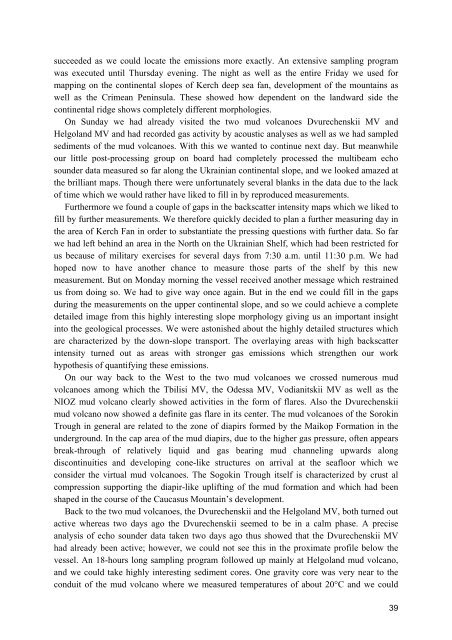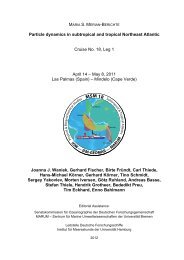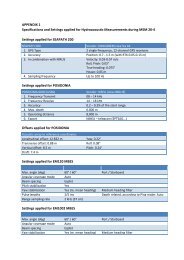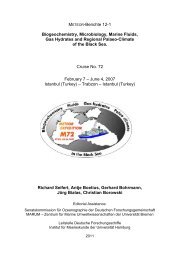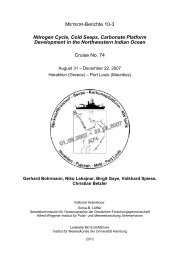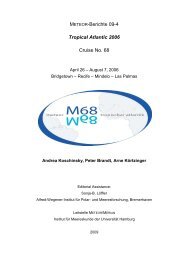LEITFADEN zur Vorbereitung und Durchführung von Expeditionen ...
LEITFADEN zur Vorbereitung und Durchführung von Expeditionen ...
LEITFADEN zur Vorbereitung und Durchführung von Expeditionen ...
Sie wollen auch ein ePaper? Erhöhen Sie die Reichweite Ihrer Titel.
YUMPU macht aus Druck-PDFs automatisch weboptimierte ePaper, die Google liebt.
succeeded as we could locate the emissions more exactly. An extensive sampling program<br />
was executed until Thursday evening. The night as well as the entire Friday we used for<br />
mapping on the continental slopes of Kerch deep sea fan, development of the mountains as<br />
well as the Crimean Peninsula. These showed how dependent on the landward side the<br />
continental ridge shows completely different morphologies.<br />
On S<strong>und</strong>ay we had already visited the two mud volcanoes Dvurechenskii MV and<br />
Helgoland MV and had recorded gas activity by acoustic analyses as well as we had sampled<br />
sediments of the mud volcanoes. With this we wanted to continue next day. But meanwhile<br />
our little post-processing group on board had completely processed the multibeam echo<br />
so<strong>und</strong>er data measured so far along the Ukrainian continental slope, and we looked amazed at<br />
the brilliant maps. Though there were unfortunately several blanks in the data due to the lack<br />
of time which we would rather have liked to fill in by reproduced measurements.<br />
Furthermore we fo<strong>und</strong> a couple of gaps in the backscatter intensity maps which we liked to<br />
fill by further measurements. We therefore quickly decided to plan a further measuring day in<br />
the area of Kerch Fan in order to substantiate the pressing questions with further data. So far<br />
we had left behind an area in the North on the Ukrainian Shelf, which had been restricted for<br />
us because of military exercises for several days from 7:30 a.m. until 11:30 p.m. We had<br />
hoped now to have another chance to measure those parts of the shelf by this new<br />
measurement. But on Monday morning the vessel received another message which restrained<br />
us from doing so. We had to give way once again. But in the end we could fill in the gaps<br />
during the measurements on the upper continental slope, and so we could achieve a complete<br />
detailed image from this highly interesting slope morphology giving us an important insight<br />
into the geological processes. We were astonished about the highly detailed structures which<br />
are characterized by the down-slope transport. The overlaying areas with high backscatter<br />
intensity turned out as areas with stronger gas emissions which strengthen our work<br />
hypothesis of quantifying these emissions.<br />
On our way back to the West to the two mud volcanoes we crossed numerous mud<br />
volcanoes among which the Tbilisi MV, the Odessa MV, Vodianitskii MV as well as the<br />
NIOZ mud volcano clearly showed activities in the form of flares. Also the Dvurechenskii<br />
mud volcano now showed a definite gas flare in its center. The mud volcanoes of the Sorokin<br />
Trough in general are related to the zone of diapirs formed by the Maikop Formation in the<br />
<strong>und</strong>ergro<strong>und</strong>. In the cap area of the mud diapirs, due to the higher gas pressure, often appears<br />
break-through of relatively liquid and gas bearing mud channeling upwards along<br />
discontinuities and developing cone-like structures on arrival at the seafloor which we<br />
consider the virtual mud volcanoes. The Sogokin Trough itself is characterized by crust al<br />
compression supporting the diapir-like uplifting of the mud formation and which had been<br />
shaped in the course of the Caucasus Mountain’s development.<br />
Back to the two mud volcanoes, the Dvurechenskii and the Helgoland MV, both turned out<br />
active whereas two days ago the Dvurechenskii seemed to be in a calm phase. A precise<br />
analysis of echo so<strong>und</strong>er data taken two days ago thus showed that the Dvurechenskii MV<br />
had already been active; however, we could not see this in the proximate profile below the<br />
vessel. An 18-hours long sampling program followed up mainly at Helgoland mud volcano,<br />
and we could take highly interesting sediment cores. One gravity core was very near to the<br />
conduit of the mud volcano where we measured temperatures of about 20°C and we could<br />
39


